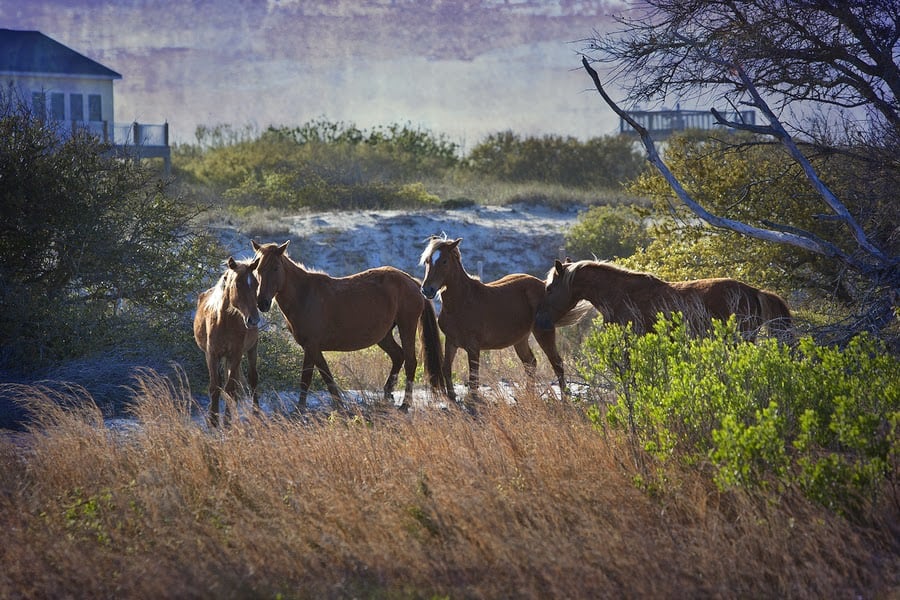Outer Banks, NC: A Wildlife Wonderland
If you're an animal lover, there are few places in the country that offer the exceptional variety of wildlife as unique as the Outer Banks of North Carolina. When searching for things to do in this area, don't neglect a chance to educate and fascinate yourself and your family with up-close encounters.Bring your camera! The photo ops you'll discover during your stay make for cherished memories, as well as viral social media posts.
 Wild Horses Roaming Free
Wild Horses Roaming Free
One of the biggest attractions for visitors to the Outer Banks is the wild horses that roam free. Spanish Mustangs with a 500-year heritage occupy the beaches. Surviving in isolation for nearly 400 years, the settlement and expansion of the Outer Banks made life difficult for these thoroughbreds that once had run of the entire area. The small groups that remain are now sequestered by the National Park Service into a specific 11-mile section of Currituck Banks and Corolla. You won't see actual Spanish Mustangs in the wild anywhere else in the world.Because the beaches are undeveloped and remote, driving a four-wheel-drive vehicle is practically mandatory if you don't want to get stuck. If you don't own a truck or SUV with this capability, you can rent them or rent four-wheel all-terrain vehicles (ATVs) when you're ready to explore.
Currituck National Wildlife Refuge
Although Corolla and Carova have been popular with visitors since the 1930s, the Currituck National Wildlife Refuge wasn't established until 1984. With the development of surrounding areas and the completion of NC Highway 12 came an inevitable collision between nature and man. The U.S. Fish and Wildlife Service stepped in and deemed over 4,500 acres as a sanctuary for mammals, reptiles, fish, birds and other creatures.The wild horses (mentioned above) are a highlight for animal lovers, but certainly not the only attraction. With several varieties of snakes and turtles, exploration of the refuge can be fascinating. Box and snapping turtles make their homes here and the endangered loggerhead turtle drops by about once a year to lay eggs. Birders find this area of particular interest because it is in the migratory route for over 300 species of birds. Depending on the time of year, you'll likely see Canadian geese, white swans, blue herons, osprey, egrets and more. Then there are the four-legged creatures that everyone loves to observe: raccoons, rabbits, deer and others. Guided tours are available or, for the truly adventurous, you can head out on your own via four-wheel-drive vehicle or boat.
The Outer Banks Wildlife Shelter
If you're looking for things to do on the Outer Banks and you prefer to view local wildlife in a more civilized manner, take a tour of The Outer Banks Wildlife Shelter. With a mission to rehabilitate and release the injured, sick and orphaned animals they care for, the shelter also aims to teach humans how to successfully live alongside these creatures.Among others, you might see pelicans, possums, owls, ducks, gulls, turtles and more critters at the shelter. Tours are given every day at 2:00 p.m.
Outer Banks Center for Wildlife Education
Have little ones that don't care much for trekking through marshes and dunes? They can still experience area wildlife through the Outer Banks Center for Wildlife Education. With creative programs including "Swish Like a Fish," "Sea Turtles in Jeopardy" and "Bird Brains," your children can take a hands-on approach to discovering the wonders of nature in a safe, fun environment.Numerous programs are available: some as drop-ins with no notice required and others offering reserved space. Adults will love it, too!
Nags Head Woods Ecological Preserve
According to the Nature.org website, "Over 100 species of birds have been documented at Nags Head Woods. The preserve is an important nesting area for more than 50 species, including green heron, wood duck, red-shouldered hawk, clapper rail, ruby-throated hummingbird, pileated woodpecker, prothonotary warbler, and summer tanager. Fifteen species of amphibians and 28 species of reptiles have been documented as well. An extensive marsh system bordering Roanoke Sound on the western side of the preserve supports a wealth of wildlife including river otter, egrets, herons, and many species of migratory waterfowl."There are few other places in the country where this diverse a selection of wildlife is practically right outside your door. With such gorgeous animals all throughout the Outer Banks of NC, take advantage of the opportunities to see them up close during your visit. Be sure to bring your camera... these will be some of the most memorable things you do.







